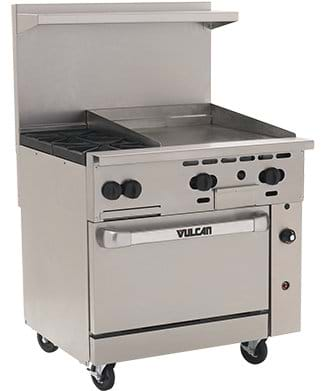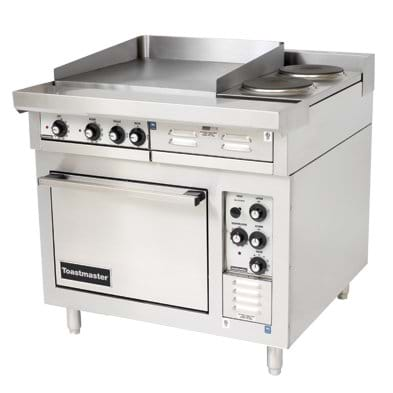There’s a constant debate in the foodservice industry over gas ranges vs electric ranges: what’s better, what has more problems, what costs what and so on. While we don’t actually sell commercial restaurant ranges, we sell restaurant tabletop supplies to restaurants across Canada and want to add value to our customers’ lives. Based on conversations with our customer’s the answer to what’s a better cooking method is: it depends. It depends on a chef’s upbringing, training, kitchen set up, restaurant menu and personal preference. To clarify, we’ll be talking about a range as commercial restaurant equipment which includes an oven + stovetop. What we’ll attempt to do in this post is share an unbiased pro and con list of commercial gas ranges versus commercial electric ranges so you can determine what makes the most sense for your back of the house needs.
Commercial Gas Ranges

Photo Source: Vulcan
Manufacturers include Garland, Wolf, Cooking Performance Group, Bakers Pride, Imperial, Vulcan and Southbend.
- Multiple configuration options including ovens, storage cabinets, griddles, broilers, and salamanders
- Available in 20” to 72” width
- 2-12 burners
- 0-2 ovens
Pros:
- More even stovetop heat for cooking
- Easy to gauge the precise level of heating on burners
- Less expensive to operate
- Instant, constant heat on burners
Cons:
- Can be more costly to install if gas line isn’t already there
- Higher risk of gas leaks
- Pilot light starters burn more gas than electronic starters as pilot lights are constantly burning blue flame near the burner. If the gas range has a pilot light starter, it would be more costly to operate and therefore a “con”
- Gas ovens produce a humid heat making it less optional for dry roasting
Commercial Electric Range

Photosource: Toastmaster
Manufacturers include Toastmaster, Garland, and Vulcan.
- Multiple configuration options including ovens, storage cabinets, griddles, and broilers
- Available in 36” to 60” width
- 6-10 burners
Pros:
- Easier to install
- Less costly to install
- Generally less expensive to purchase
- Easier to clean
- Dry Oven heat best for roasting
- Even heat distribution in oven for baking
Cons:
- Subject to power outages
- Stovetop slower to cool when turned off
- Stovetop slower to heat up when turned on
- More expensive to operate as it takes 3 times as much energy to produce and delivery electricity to your range than gas



Hopefully this list provides you with the information needed to make the best decision for your restaurant. If we’ve missed any pros or cons of either range be sure to let us know by either commenting on this post, tweeting us at @NatlEventSupply, on our Facebook timeline, LinkedIn page or Google Plus page.